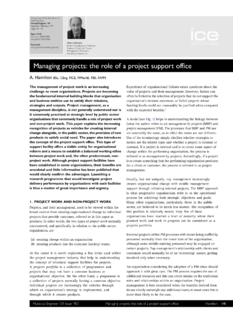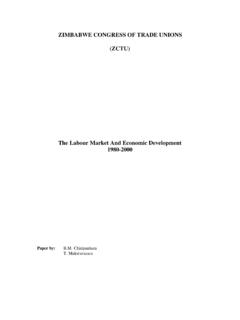Transcription of Informal Cross Border Trade in EAC Implications for ...
1 Draft Terms of Reference for EABC Services Contract Informal Cross Border Trade in EAC Implications for regional integration and Development Part of a series of Publications by CUTS GRC in conjunction with National Partners and under the Assistance of Deutsche Gesellschaft f r Technische Zusammenarbeit (GTZ), BIEAC Project. With Support from gtz 2010 by Victor Ogalo CUTS African Resouce Centre, Nairobi 2 Research Paper | CUTS Geneva Resource Centre Executive Summary Informal Cross Border Trade in EAC A significant proportion of Cross EAC Border Trade is conducted informally. There is no universally accepted definition of the Informal sector to start with. But in this paper, the term " Informal Cross Border Trade " is used to refer to imports and exports of legitimately produced goods and services ( , legal goods and services), which directly or indirectly escape from the regulatory framework for taxation and other procedures set by the government, and often go unrecorded or incorrectly recorded into official national statistics of the trading countries.
2 Since the commencement of the EAC Customs Union in 2005, several official efforts are being put in place to increase formal Trade links among Partner States. Despite the policy pronouncements to promote Trade integration among EAC Partner States, formal Trade links is still facing several constraints. Indeed, some of the constraints push traders into engaging in Informal Trade as there are also exclusive incentives that pull traders to remain in ICBT. Yet, the coexistence of ICBT with formal Trade integration has not been officially recognised. There are no official purposive efforts to put in place an appropriate environment to streamline the activities of Informal Cross Border traders. Incidentally, some of the studies reviewed in this paper tend to suggest that it is the Informal contacts that do strengthen regional integration networks and relationships more than formal links.
3 While it may be relatively easy to eliminate constraints to formal trading, the same may not provide better incentives for traders already in the Informal sector to shift or formalise their trading practices. All the reviewed surveys in this paper suggest that ICBT still represents a significant proportion of regional Cross Border Trade in EAC. Official statistics provided in this study indicate that Uganda has been maintaining an increasing negative Trade balance with Kenya. On the other hand, the ICBT statistics indicate a positive Trade balance. If the two sets of data (both for ICBT and official Trade ) were to be added together, it would be the case that Uganda s official Trade data actually falls short by more than 80 percent of what should be Uganda s inter EAC exports.
4 Key Characteristic of ICBT Participants Who are the participants and how do they practice ICBT: The study has established that participants in the ICBT are both from Informal and formal firms. Yet it is actually the formal firms who are stigmatising and fighting the Informal one through the government. The Informal firms engaging in ICBT do operate entirely outside the formal economy. But, the formal firms in this type of business are actually either fully evading Trade related regulations and duties by passing their commodities through unofficial routes or are partially evading Trade related regulations and duties even as they pass their goods through official routes. In the latter case, the traders involve illegal practices such as under declaration of the quantities, weight or value of goods so as to pay lower custom duties (where custom duties are applicable); falsifying the description of products (mis classification) so that they are treated as products subject to none or lower tariffs; mis 3 Research Paper | CUTS Geneva Resource Centre declaration of country of origin to avoid any taxes that may be applicable; and bribery of customs officials and police officers.
5 Education level, gender and age: The study has shown that Cross Border Trade is increasingly becoming more complex and and more people have completed their secondary education compared to two decades before. A majority of the players also fall in the age bracket of 20 40 years where percent have completed secondary education, percent have professional/semi professional diploma and certificate and 10 percent have a degree, with the number of those with diploma, certificate and degrees rising by year. Type of good traded: On the type of goods involved in ICBT, the study shows that Informal Cross Border Trade in EAC concerns almost all types of goods staple food commodities and even food aid that have a direct impact on regional food security; low quality consumer goods such as shoes, clothes, textile and vehicle and bicycle parts and even fake drugs; and, some of the goods reflect the same ones that benefit from export promotion schemes, such as textiles.
6 Knowledge of the customs union protocol: A remarkable finding is that many ICBT traders are well aware of the various general provisions of the Customs Union, including most of the regulatory requirements. However, some of them attribute their continued engagement in ICBT to presence of physical and technical barriers in formal Trade ; others to the incentives inherent in ICBT; and still others attach their socio economic problems hindering beneficial engagement in formal trading. Mode of transportation across the Border : The main modes of transport used in ICBT are vehicles, bicycles, head/hand, motorcycles, wheel chairs, animals (donkeys), push carts, boats/canoe etc. People with disabilities, like those on wheel chairs are paid to help move small/light but valuable products sugar, salt, soap, cooking oil and plastics.
7 In most cases, the flows of ICBT goods appear to be in small quantities. Where big consignments are involved, they are usually divided into smaller quantities to avoid attention when passing across borders. Small quantities og goods are passed through official points which in when totalled accounts for a significant amount. These small quantities passed across the Border are not necessarily sold immediately; they are piled in stores which are jointly hired by the traders until a reasonable volume is reached and the players jointly hire means of transport to haul their consignment to the rest regions of the country. Push and Pull Factors for ICBT Growth The growth of ICBT generally represents a normal market response to overly cumbersome, rigid, time consuming and inefficient bureaucratic export/import procedures and regulations, which are seen as significantly increasing the cost of both joining the formal economy and operating within it.
8 But, it is also established that ICBT markets in EAC pre dates colonial and post colonial state boundaries. For this reason, what we see continues today as ICBT is simply a longstanding indigenous pattern of Trade that makes more sense than formal Trade channels. In this perspective, ICBT is not significantly influenced by the factors mentioned above; rather, its 4 Research Paper | CUTS Geneva Resource Centre entrenchment is simply a re establishment of the extensive barter Trade and migration of people that were a feature of economic and social life predating colonisation in EAC. Other push factors towards ICBT are based on the weak economies of EAC that have seen formal employment shrink, especially, following the inappropriately implemented structural adjustment programmes (SAPs) of the early 80 s.
9 The consequence has been a rise in rural urban migration in search of often non existent employment. Together with the low wages from the formal employment, retrenchments and generally underemployment, these have been key in pushing people to look for alternative ways to supplement their incomes, and ICBT has been one such alternative. All in all, there are several reasons which explain the existence and continued growth of ICBT in EAC. There is no one reason that can be attributed to it; rather, a confluence of factors have conspired either as incentives that pull traders or as problems that push them to engage in ICBT. Implications of ICBT to EAC Positive Implications ICBT contributes to the economies of EAC countries in various ways.
10 It enables small scale entrepreneurs to escape poverty and to meet the education, housing and other basic needs; ICBT traders employ people in their home countries and in the countries where they source their goods; and, it is also a supplementary source of family income to people who are under employed and a source of employment to some people who were retrenched following economic restructuring that was occasioned by structural adjustment programmes (SAPs). Judging from the monthly values of income that traders realise from ICBT, it is apparent that the majority of ICBT participants survive on more than US$2 a day which some of them would never have achieved under formal employment, especially considering the shrinking economies of EAC.







